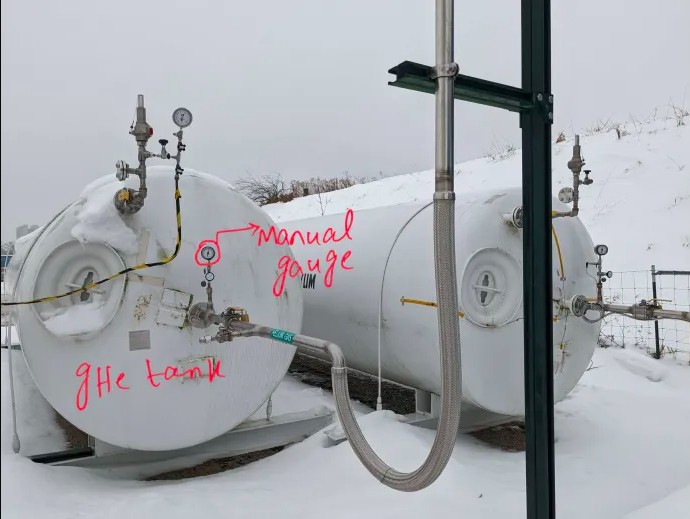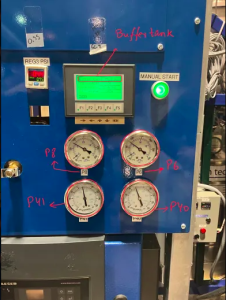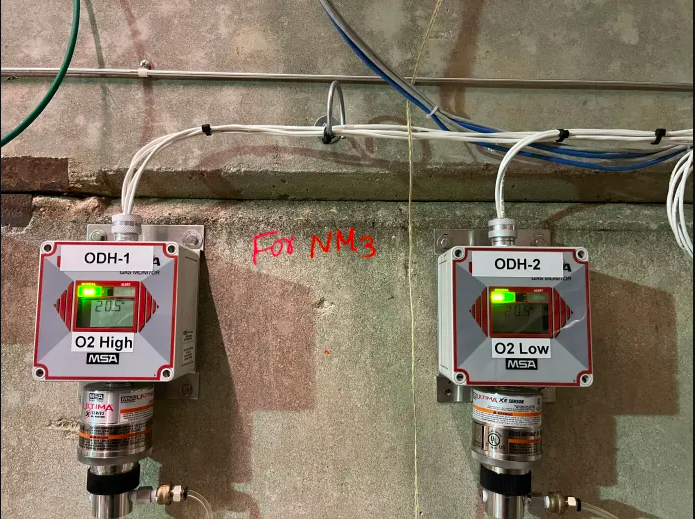Preparation
Please read the Polarized Target Monitoring and Maintenance Guide (SeaQuest doc-10182) and ask the target expert about any recent addition/change to this guide.
Duties
- Respond to alarms (reach out to the Target Expert on shift, if the Target Expert doesn't respond/acknowledge, then try to fix it, or contact target-group members immediately).
- Make prior arrangements to make yourself available for the entire week (of your shift) to assist the "Target Expert" of the week in accomplishing the tasks mentioned on Target Expert page.
You will have to be in touch with the Target Expert on shift as frequently as possible while checking the entire system's status. - Keep all your training up to date before your shift.
- Ensure to go through the "Target Expert's Checklist" (a Table on the Target Expert page) at least a couple of times a day.
- Check Target System Maintenance page and arrange/perform necessary maintenance with the Target Expert.
- Fill-out the spreadsheet everyday: https://docs.google.com/spreadsheets/d/1rVhYVyClAVFNEt_vyj8aQ8GLVS3DRL51QKbansgkOr8
- Help Target Expert to go over the Target Maintenance:
Target Maintenance Record:
Ensure to record parameters' values on the SpinQuest_Polarized_Target_Parameters spreadsheet: https://docs.google.com/spreadsheets/d/1rVhYVyClAVFNEt_vyj8aQ8GLVS3DRL51QKbansgkOr8
The above spreadsheet needs to be kept updated one day or every other day. This spreadsheet holds the information below:
- Outside NM4 tanks (gaseous helium (gHe) and liquid nitrogen (LN2)) level.
Outside gaseous helium tank
If this pressure reading gets below 45 psig, then IMMEDIATELY check with the Target Expert. You can check this pressure remotely using the strip charts.
https://e906-gat1.fnal.gov/data-summary/e1039/target-all-auto.php
If there is a need to arrange the gHe tube trailer to refill, please follow the steps on How to order LN2 refill to the tank, gHe tube-trailer, LN gHe cylinders, and LN2 portable Dewars at FNAL
Outside Liquid Nitrogen (LN2) tank
If this level is below 24 In.H2O, then please follow the steps on How to order LN2 refill to the tank, gHe tube-trailer, LN gHe cylinders, and LN2 portable Dewars at FNAL to arrange a refill.
- Check the HR3 parameters on the HR3 like annotated in the pictures:
- Checking the number of gaseous helium (gHe) and gaseous nitrogen (gN2) bottles in the outside NM4 gas rack. To confirm their number, check the labels (Helium for gHe and Nitrogen for gN2) on the cylinders. To check whether these cylinders are empty or filled. You can check their tags on or check from their caps; if there is blue wrapping inside the cap on the opening valve, these cylinders are filled; if not, they are empty. Note: The minimum two cylinders for both of them are enough; if it is lower, then check with the target expert to place an order.
- Checking the LN2 portable (180L) dewars. Note: If snow falls, we must put the LN2 portable dewar inside the NM4 hall near the loading dock because, due to cold, the 22 psi relief valve on the dewar will freeze and keep venting all the time, which will empty the dewar soon. During beam operations, we cannot put the LN2 portable dewar in the NM4 hall.
- The material (CH2/CD2 & NH3 (10g)) is filled with LN2 in the target preparation/handling area. This activity should be performed weekly. Check with the target expert for the week and arrange the material dewar refill with LN2.
- Checking the ODH sensors reading for the NM4 hall (for cryo platform) and NM4 ground level (for NM3). Please put the reading for four sensors, two for the cryo platform (ODH 1 & ODH 2) and two for NM3 (ODH 1 & ODH 2), in the above spreadsheet.
The normal reading is 20.8. If it is changing plus or minus 0.3, then first inform to Prof. Dustin and Kun. If they let you to send an email to Evan and Kim (overhage@fnal.gov) then do that.
- Recording the pressure gauge value for the LCW supply to the Roots pump. Please see the following pictures, whose value needs to be recorded in the above spreadsheet.
- Note: If the pressure values go below 50 psi or goes above 55 psi, please inform in the discord channel.
LCW accumulation bucket on Shielding blocks and on the lower level of NM4:
1. Target helper has to empty out the LCW accumulating bucket from the shielding blocks and lower level of NM4. After accumulating them empty it out into big white barrels.
You can make various viewpoints of the full system strip charts using this page: https://e906-gat1.fnal.gov/data-summary/e1039
The Target TV page 'https://e906-gat1.fnal.gov/data-summary/e1039/target-par-preset/target-tv.php' gives you an overall idea about the full system (but not all the parameters).
In addition to the "Target TV", there are two dedicated pages designed for the convenience of Target Operator / Target Helper.
1. https://e906-gat1.fnal.gov/data-summary/e1039/target-par-preset/target-helper.php
2. https://e906-gat1.fnal.gov/data-summary/e1039/target-par-preset/target-helper-2.php
Let's go through the sub-systems.
1. LCW
Two target sub-systems use LCW (Low Conductivity Water) for cooling.
1. Helium Liquefier System (UVA-QT): see QT System Manual for more details.
2. Roots pump-system: see Roots Pumps System Manual for more details.
The nominal values (as of 01/06/2024):
Parameter | Avg. Value |
|---|---|
| Inlet Pressure | ~ 65 psig |
| Outlet Pressure | ~ 48 psig |
| Inlet Temperature | ~ 79 Fahrenheit |
| Outlet Temperature | ~ 89 Fahrenheit |
IMPORTANT: if you notice there is no LCW flow, then notify the Target Expert IMMEDIATELY, to stop the coldhead compressors and the roots pumps.
Also, if you notice any of the following you will have to coordinate with the Target Expert to perform the later mentioned steps.
* Lower inlet pressure
* Higher inlet temperature
If you are on the cryo-platform, take the stairs (towards the lower level) and stop mid-way when you see these gauges towards the east wall of the hall.
You will see labels ”LCW Supply” and “LCW Return” on those two separate piping.
Both “LCW Supply” and “LCW Return” have a pressure gauge and a temperature gauge.
The nominal values for the outlet LCW temperatures from the QT coldhead compressors should be below 100 Fahrenheit (see the image below)
If you notice this increase above 105 Fahrenheit, then the coldhead compressors can be tripped at any time, so coordinate with the Target Expert on Shift.
The nominal values for the LCW for the roots pumps system should be as shown in the following pictures.
Location: at the roots-pumps (cryo-platform: westbound)
Note: The 2nd flow meter from the right is from the rotary vane pump and it usually takes about 5-10mins to show a flow after it is started.
You can monitor these outlet flow from the strip charts remotely, and a sample screenshot is shown below.
2. Insulation Vacuum Chamber (IVC)
This is the vacuum space of the superconducting magnet. When the system is running/operational, the IVC should be below 9 x 10E-6 Torr.
If this value goes above 1 x 10E-5 Torr, then IMMEDIATELY contact the Target Expert to fix it.
Note: during magnet LHe fills, LN2 fills, and fridge fills this IVC can fluctuate but it should go back to below 9 x 10E-6 Torr soon.
These are the possibilities for increasing IVC
1) The backing pump is off or not running: you will need to access NM3 and get it started while monitoring IVC.
2) The turbo pump is off or not running: you will need to access NM4, and check the turbo status from its controller at the slow controls rack, clear any alarms/error messages, and start it.
The one on the left (TPG361) is the IVC readout device, and the one on the right (DCU 600) is the controller for the turbo pump. The nominal rotation frequency of DCU600 is 660 Hz (set value (upper), and actual value (lower) are displayed on that screen #309).
3) The IVC readout can have failures. You may need to restart it if needed. There is a switch on the back of that TPG361 readout device (see the left-hand side module of the above picture) to turn ON/OFF. Then you will need to LONG PRESS the UP arrow to get the reading on the display.
3) A leak in the piping: you will need to access the cave and check the piping, the check valve (red one on the magnet surface, north side)
4) The fridge pressure also maybe keep increasing. Check whether the roots pumps are running, if not start them.
5) A sudden power outage: IMMEDIATELY contact the Target Expert and have the backup power setup running and start the backing pump and turbo pump while monitoring the IVC pressure.
The top-left plot shows the IVC https://e906-gat1.fnal.gov/data-summary/e1039/target-par-preset/target-tv.php
3. UVA-QT System
The most important things to frequently check:
1) LCW supply (see the section 1 above).
2) LCW outlet temperatures from the coldheads (see the section 1 above).
3) HR3 status (should be always running in the LOAD mode): see HR3 Manual for more details. The arrow shown on its display should be a "SOLID-ARROW", not "HOLLOW-ARROW"
You can check its status by plotting "HR3 Enabled" from the strip-charts https://e906-gat1.fnal.gov/data-summary/e1039/target-all-auto.php,
and it should be the value "-1" when it is running, and "0" when it is off.
4) Check the Compressors' status. There are 10 coldhead compressors as two arrays on the east-side of the cryoplatform. Each array of compressors corresponds to a liquefier (A: bottom-row, B: top-row).
Essentially, each compressor screen should show "EASYCOOL", but no "ALARMS" or "ERRORS" in the operational conditions.
On the strip charts,
1) Ensure both Liquefiers are producing LHe. Check the top-right plot in the https://e906-gat1.fnal.gov/data-summary/e1039/target-par-preset/target-tv.php.
2) Ensure the purifier has LN2 level above 75%. Check the top-middle plot in the https://e906-gat1.fnal.gov/data-summary/e1039/target-par-preset/target-tv.php.
If the level is below 75%, then perform a refill using the procedure: docdb 10337
3) Check the difference between the parameters "Outside gHe tank(psig)" and "PT501 (A or B or both)" using https://e906-gat1.fnal.gov/data-summary/e1039/target-all-auto.php
If the difference is above 65 psig, then that indicates that the purifier needs cleaning / regeneration.
Follow Cleaning QT purifier Helium-space (pumping-purging the purifier) procedure with the Target Expert.
4) Ensure the Dewar levels are behaving properly. If you see an unusual behavior like level fluctuations (
4. Roots pumps setup
5. Checking two gHe bottles’ levels on the west-wall of the cryoplatform
6. Outside gaseous helium tank
If this pressure reading gets below 45 psig, then IMMEDIATELY check with the Target Expert. You can check this pressure remotely using the strip charts.
https://e906-gat1.fnal.gov/data-summary/e1039/target-all-auto.php
If there is a need to arrange the gHe tube trailer to refill, please follow the steps on How to order LN2 refill to the tank, gHe tube-trailer, LN gHe cylinders, and LN2 portable Dewars at FNAL
7. Outside Liquid Nitrogen (LN2) tank
If this level is below 24 In.H2O, then please follow the steps on How to order LN2 refill to the tank, gHe tube-trailer, LN gHe cylinders, and LN2 portable Dewars at FNAL to arrange a refill.
8. Gaseous helium, nitrogen cylinders supplies and Liquid Nitrogen portable dewars supply
There should be at least two cylinders from each gas type (gHe and gN2), and two portable LN2 dewars available at all times.
Please follow the steps mentioned in How to order LN2 refill to the tank, gHe tube-trailer, LN gHe cylinders, and LN2 portable Dewars at FNAL to proceed with ordering.































